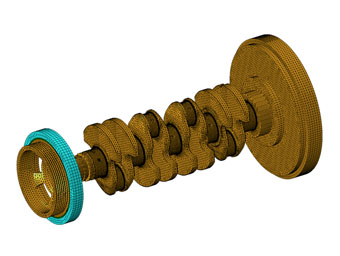Multidisciplinary Workflow to Assess Modal Fatigue Results of a 4-Cylinder Crankshaft Using AVL EXCITE, OptiStruct, and FEMFAT

The crankshaft of an engine is a highly dynamically loaded component that is continuously optimized and optimized in terms of design and production technology. In order to be able to reproduce this in the simulation, the essential influences must be considered. This includes the dynamically behaviour in combination with the engine, the material properties and the application of the loads and their transfer to other parts (bearings).
The modal approach has established itself as a proven method here, whereby a modal basis is determined in the FEM so that the crankshaft is integrated as a flexible body in the MKS model of the engine, and so that an entire engine run-up can be simulated. The modal participation factors are obtained from the MBS simulation, which are used together with the modal stresses for the safety factor calculation.
This workflow requires the combination of different simulation tools. The challenge is to organize the data transfer between the tools efficient and correct. In this example, the workflow is realized using OptiStruct from Altair for FEM calculation, EXCITE from AVL as MKS tool and FEMFAT from Magna Engineering Center Steyr as Fatigue solver.
This makes it possible to simulate a complex engine run-up with consideration of the ignition bearing forces and to calculate the fatigue life of the crankshaft in FEMFAT.
This webinar, details of the simulation workflow of the 4-cylinder crankshaft will be presented and the effects of several influencing variables on the fatigue life will be studied.
